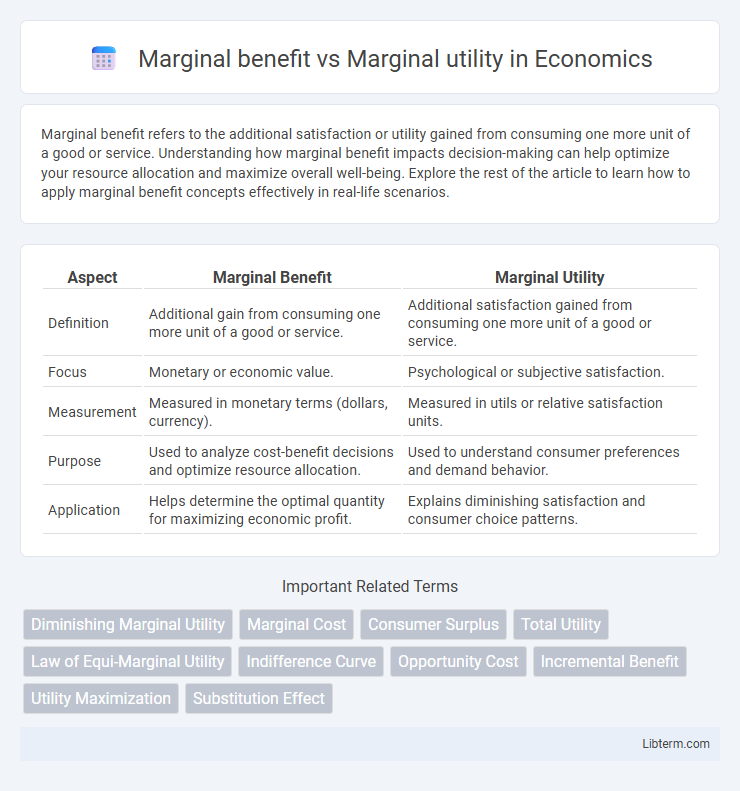Marginal benefit refers to the additional satisfaction or utility gained from consuming one more unit of a good or service. Understanding how marginal benefit impacts decision-making can help optimize your resource allocation and maximize overall well-being. Explore the rest of the article to learn how to apply marginal benefit concepts effectively in real-life scenarios.
Table of Comparison
| Aspect | Marginal Benefit | Marginal Utility |
|---|---|---|
| Definition | Additional gain from consuming one more unit of a good or service. | Additional satisfaction gained from consuming one more unit of a good or service. |
| Focus | Monetary or economic value. | Psychological or subjective satisfaction. |
| Measurement | Measured in monetary terms (dollars, currency). | Measured in utils or relative satisfaction units. |
| Purpose | Used to analyze cost-benefit decisions and optimize resource allocation. | Used to understand consumer preferences and demand behavior. |
| Application | Helps determine the optimal quantity for maximizing economic profit. | Explains diminishing satisfaction and consumer choice patterns. |
Introduction to Marginal Benefit and Marginal Utility
Marginal benefit refers to the additional gain or satisfaction a consumer receives from consuming one more unit of a good or service, directly impacting decision-making in economics. Marginal utility, a related concept, measures the extra satisfaction or usefulness derived from an additional unit of consumption, often declining as consumption increases due to the law of diminishing marginal utility. Understanding the distinction between marginal benefit and marginal utility is crucial for analyzing consumer behavior and optimizing resource allocation.
Defining Marginal Benefit
Marginal benefit refers to the additional advantage or value gained from consuming one more unit of a good or service, often measured in monetary terms or increased satisfaction. It plays a crucial role in economic decision-making as it helps individuals and businesses determine the optimal quantity to consume or produce. Understanding marginal benefit enables comparison with marginal cost to maximize overall efficiency and resource allocation.
Understanding Marginal Utility
Marginal utility refers to the additional satisfaction or benefit a consumer gains from consuming one more unit of a good or service, crucial for understanding consumer decision-making and demand behavior. It decreases as more units are consumed, a principle known as diminishing marginal utility, which influences optimal consumption choices. Unlike marginal benefit, which encompasses overall gain including price and external factors, marginal utility focuses specifically on the subjective value derived by the individual consumer per additional unit consumed.
Key Differences Between Marginal Benefit and Marginal Utility
Marginal benefit refers to the additional satisfaction or profit gained from consuming or producing one more unit of a good or service, measured in monetary terms or overall value. Marginal utility specifically quantifies the added satisfaction or pleasure a consumer derives from consuming an extra unit of a good, focusing on subjective emotional or psychological value. The key difference lies in marginal benefit's emphasis on economic or practical advantage, while marginal utility centers on individual consumer preferences and enjoyment.
The Role of Marginal Analysis in Economics
Marginal benefit measures the additional gain from consuming one more unit of a good or service, while marginal utility quantifies the added satisfaction or happiness derived from that consumption. Marginal analysis in economics uses these concepts to determine optimal production and consumption levels, where marginal benefit equals marginal cost. This approach helps allocate resources efficiently by guiding decision-making toward maximizing overall economic welfare.
Practical Examples of Marginal Benefit
Marginal benefit represents the additional gain received from consuming one more unit of a good or service, such as the extra satisfaction a consumer gets from eating an additional slice of pizza. In practical terms, businesses use marginal benefit analysis to decide the optimal production level by comparing the added revenue from selling one more product unit against its cost. For example, a farmer evaluates the marginal benefit of fertilizing an extra acre, weighing the increased crop yield value against the additional expense.
Practical Examples of Marginal Utility
Marginal utility refers to the additional satisfaction gained from consuming one more unit of a good or service, while marginal benefit is the overall gain from that additional unit, including both satisfaction and monetary value. For example, eating a second slice of pizza might provide less enjoyment than the first, illustrating diminishing marginal utility, whereas the marginal benefit includes the pleasure plus any cost savings if the pizza was discounted. Understanding marginal utility helps businesses price goods effectively and consumers make informed purchasing decisions based on incremental satisfaction.
Marginal Benefit and Marginal Utility in Decision Making
Marginal benefit measures the additional gain received from consuming one more unit of a good or service, directly influencing consumer choices by quantifying the value of incremental consumption. Marginal utility represents the change in satisfaction or happiness derived from consuming an extra unit, guiding decision making through subjective preferences and diminishing returns. Both concepts are essential in optimizing resource allocation, as individuals compare marginal benefit and marginal utility against marginal cost to maximize overall welfare.
Limitations and Criticisms
Marginal benefit and marginal utility face limitations in measuring real-world decision-making due to their dependence on subjective preferences and the assumption of rational behavior, which often ignores emotional and psychological factors. Critics argue that marginal utility struggles to quantify satisfaction accurately, as utility is an abstract concept lacking a consistent measurement unit across individuals. Furthermore, marginal benefit calculations can oversimplify complex economic interactions by focusing narrowly on incremental changes without accounting for broader market dynamics or externalities.
Conclusion: Importance in Economic Theory
Marginal benefit and marginal utility are fundamental concepts that illustrate the value individuals place on additional units of goods or services, shaping consumer decision-making and market behavior. Understanding the distinction between marginal benefit, often expressed in monetary terms, and marginal utility, measured by satisfaction or happiness, is crucial for efficient resource allocation and pricing strategies in economic theory. These concepts underpin critical economic models, such as demand curves and cost-benefit analysis, reinforcing their importance in predicting consumer responses and optimizing economic outcomes.
Marginal benefit Infographic

 libterm.com
libterm.com